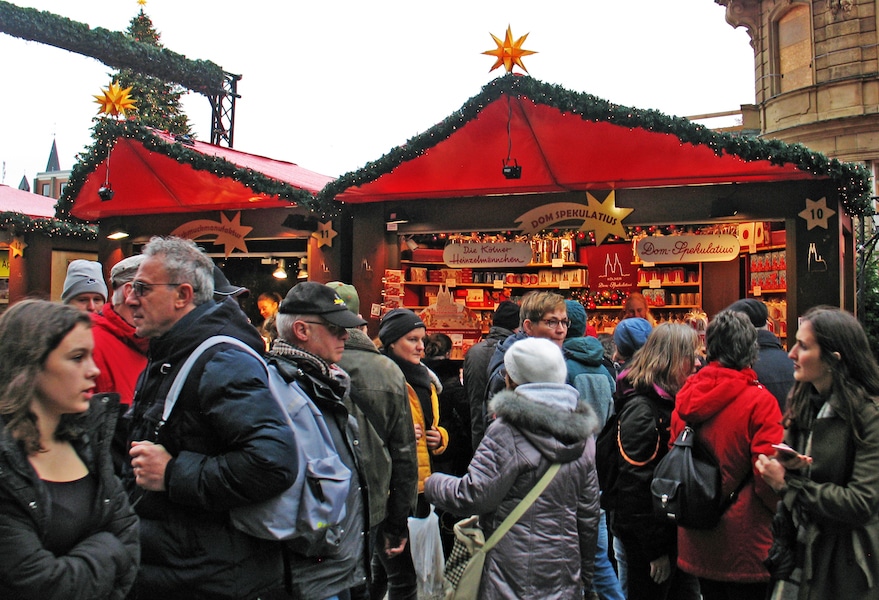
Festive crowds pack the Cologne Christmas Market in the shadow of the city’s historic cathedral. Photo by Susan McKee
By Susan McKee
I wrapped my mittened hands around the warm mug of Glühwein and inhaled the festive scent of cinnamon, cloves and orange peel.
Standing in the glow of Cologne‘s Christmas Market located adjacent to the city’s massive 13th-century cathedral, I slowly sipped the warm mulled wine as all around me swirled the sights and sounds of the holiday season.
Topped by two towering Gothic spires, the Cologne Cathedral is Germany’s most visited landmark. An average of 20,000 people walk through this UNESCO World Heritage site every day. But on this particular evening most of the crowd had come to shop for holiday gifts and confections while listening to a choir singing Christmas carols beneath an enormous tree decked with sparkling white lights and silvery garlands.
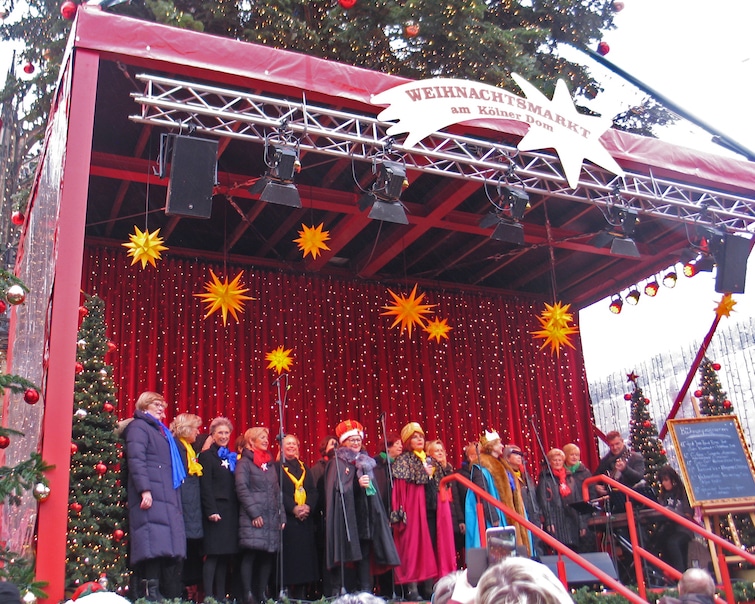
The main stage at the Cologne market features Christmas Carols by members of the cathedral choir. Photo by Susan McKee
There are more than 160 stalls at Cologne’s Christmas market. They house vendors offering seasonal treats such as gingerbread cookies, candy canes and hot roasted chestnuts plus specialty Christmas ornaments, traditional handicrafts and handmade wooden toys.
Gold, frankincense, and myrrh were the first Christmas presents. According to the Bible, these precious substances laden with spiritual symbolism were brought from “the East” by three mysterious travelers and presented to the baby Jesus in Bethlehem.
Today, the bones of these three wise men now rest in an elaborate reliquary above and behind the altar in Cologne’s cathedral. So this seemed the logical place to begin an exploration of European Christmas markets or, as they are known in Germany, Christkindlmärkte or Weihnachtsmärkte.
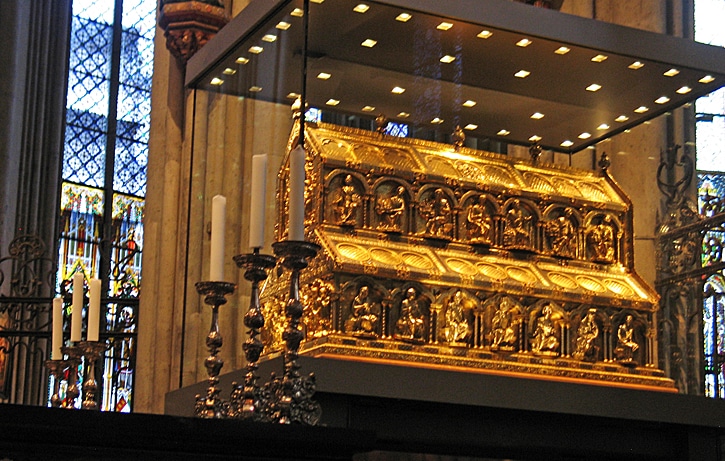
The Three Kings reliquary inside the Cologne Cathedral is said to hold the bones of the three wise men who followed a bright star to Bethlehem to attend the birth of the baby Jesus. Photo by Susan McKee
In the early 16th Century, German cleric and theology professor Martin Luther (who became a seminal figure in the Protestant Reformation after nailing to the door of the All Saints’ Church in Wittenberg his critique of the papacy’s practice of granting indulgences to wealthy contributors) suggested parents celebrate Christmas by giving their children presents “from the Christ Child.” They did and Christ Child Markets or Christkindlmärkte have grown in popularity ever since. Today, there are thousands of them across Western Europe. Berlin alone has 70. The one in Dresden is the oldest, dating from 1434.
The Christkindlmarkt just outside the Cologne cathedral is distinctive for its full schedule of Christmas entertainment, from holiday choirs to Punch and Judy puppet shows. There are several other markets in the historic town, and local retailers also decorate for the season. Be sure to stop by Café Eigel, which features a distinctive display of elaborately decorated gingerbread houses.
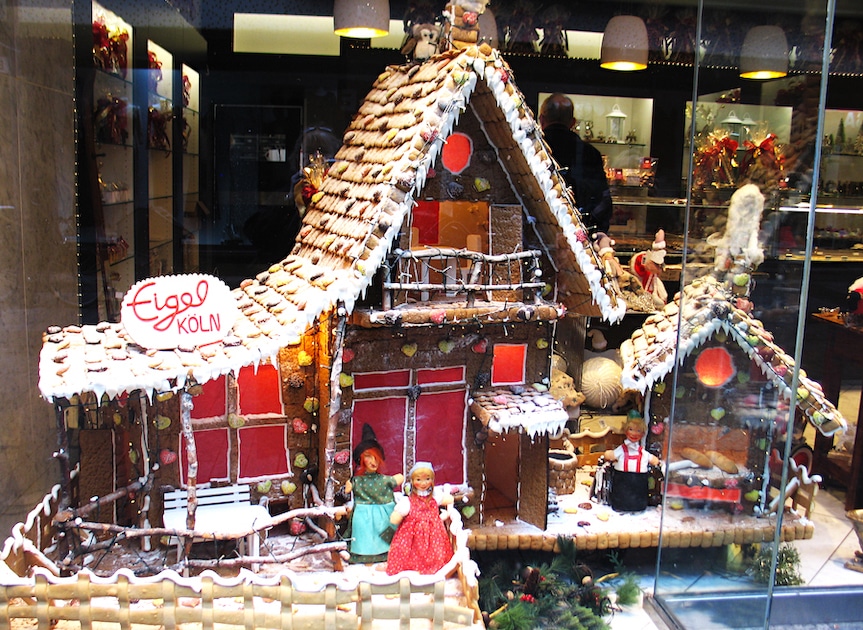
Are the gingerbread houses frosted and baked by Café Eigel in Cologne intended for decoration or consumption? The answer is both. But the houses that brighten homes and offices could fall prey to hungry children by the time New Year’s Eve arrives. Photo by Susan McKee.
Europe’s Christmas markets are magical places. Bundled up in warm jackets with woolen scarves and mittens, people of all ages enjoy the sparkling lights, scents of evergreen, tastes of mulled wine and holiday cookies. Some markets add Ferris Wheels and merry-go-rounds; others offer the chance to feed real reindeer. The sounds of holiday bells and songs fill the crisp, pine-scented air.
After Cologne, I headed south. My next stop was the historic university town of Heidelberg, where the centerpiece of the Christkindlmarkt is an ice-skating rink. While there visit the red sandstone castle overlooking the Neckar Valley, then walk down to the old town past the Student Jail, Old University and the cathedral. Then it was on to 12th century Freiburg, where the Weihnachtsmarkt takes place on the Rathausplatz in the center of the city. Among the traditional offerings there was a stall featuring hundreds of traditional cookie presses. Another made candles to order.

Christmas cookies are popular in holiday markets in Germany, Switzerland and France. More cookie cutters than a baker could imagine (Left) are on offer at the cathedral Christkindlmarkt in Cologne. Freiburg”s market (on Right) has a stall selling cookie presses. But when presented with fresh Christmas cookies from Colmar, France (Center) few seem to care whether they are stamped, cut or shaped. Photo by Susan McKee
A smaller yet equally enchanting German Christkindlmärkte is held in Speyer. In addition to the Kunsthandweremarkt, a special area devoted to handcrafted items, Speyer holds a nightly Old Gate in Flames fireworks show on Maximilian Street where booming pyrotechnics send forth clouds of “golden rain.” Especially pleasing for children are the ice skating rink and the double-decker children’s carousel.
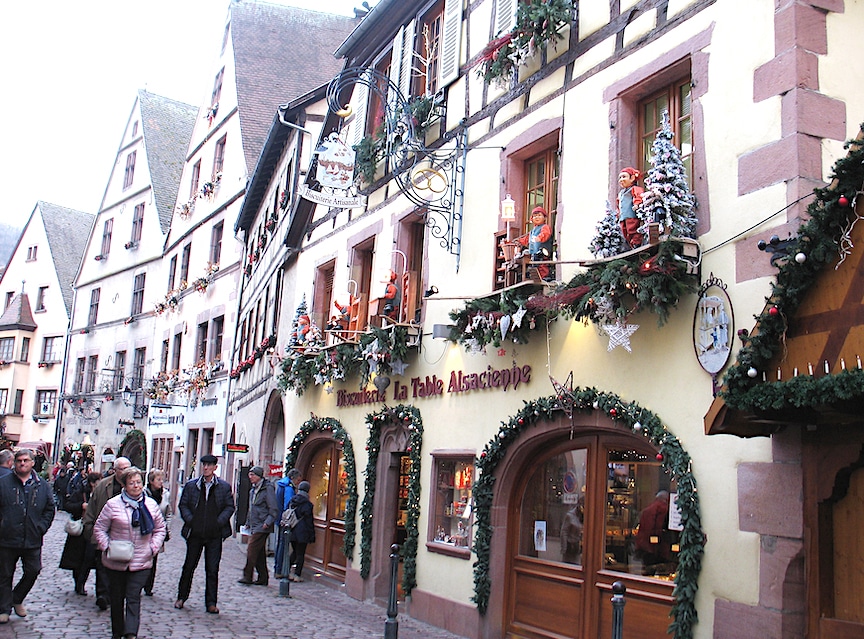
Kayserberg residents living above shops also decorate their windows for Christmas. Photo by Susan McKee.
From here I skipped across the border to France. Specifically, the region of Alsace, which, at times, has been German not French. Alsace has lots of Christmas markets so I visited three: Kaysersberg, (pop. 4,000) birthplace of Albert Schweitzer, the theologian known best as a doctor in West Africa, tiny Riquewihr, a fairy-tale medieval town of 2,000 people with half-timbered shops stair-stepping up cobblestoned streets towards vineyards blanketing the Vosges Mountains, and my personal favorite, Colmar.
A postcard-perfect Alsatian town mentioned by Charlemagne in the late 8th Century, Colmar (pop. 120,000) is known not only for its six Christmas markets but also as the hometown of Frédéric Auguste Bartholdi (1834–1904), the sculptor who created Liberty Enlightening the World. Never heard of it? That’s because his greatest work is better known as the Statue of Liberty.
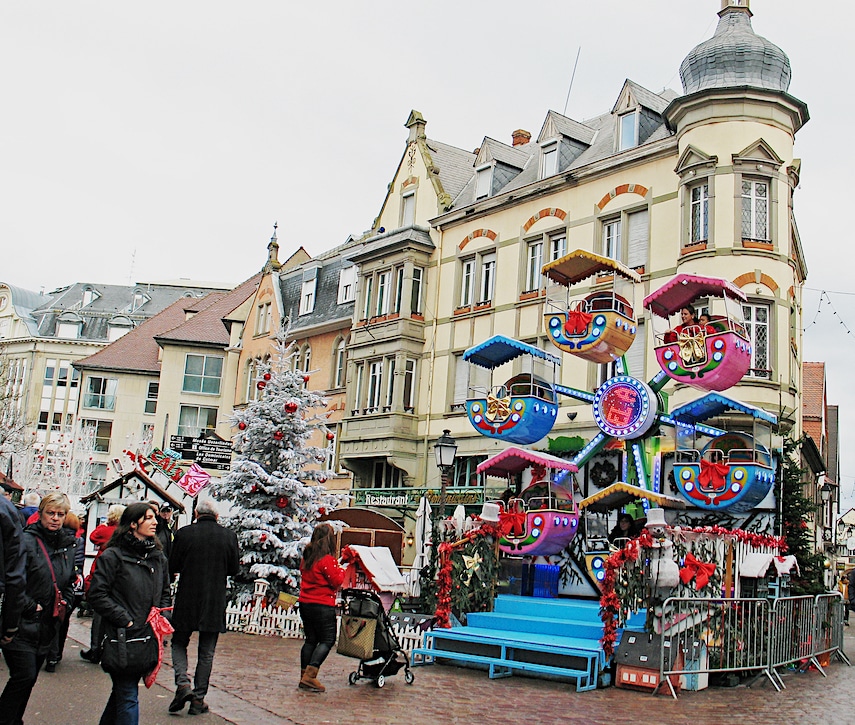
Colmar’s Christkindlmarkt features a ferris wheel especially made for children, who can enjoy the sites of the city while keeping watch over their parents drinking Glühwein below. Photo by Susan McKee.
My final stop was Basel, Switzerland’s third-largest town that’s just across the border from Germany. Home to the country’s oldest university, Basel has been a commercial hub since the Renaissance. The Weinachtmärkte, within easy walking distance of the main train station, are at Barfüsserplatz and Münsterplatz, two squares in the historic town center and are considered by some the biggest and best in Switzerland.
Dates for European Christmas markets vary, but in general they’re open from the second or third week in November through Christmas. Hours are usually 10 a.m. to 9 p.m.
I did my Christmas market tour in 2018, a year before the coronavirus became a pandemic. All of the places I visited for this story are open to visitors, but restrictions could be implemented if the Omicron variant starts to spread. Some markets are permitting access only to those who can show proof of full vaccination or verified recovery from a COVID-19 infection.
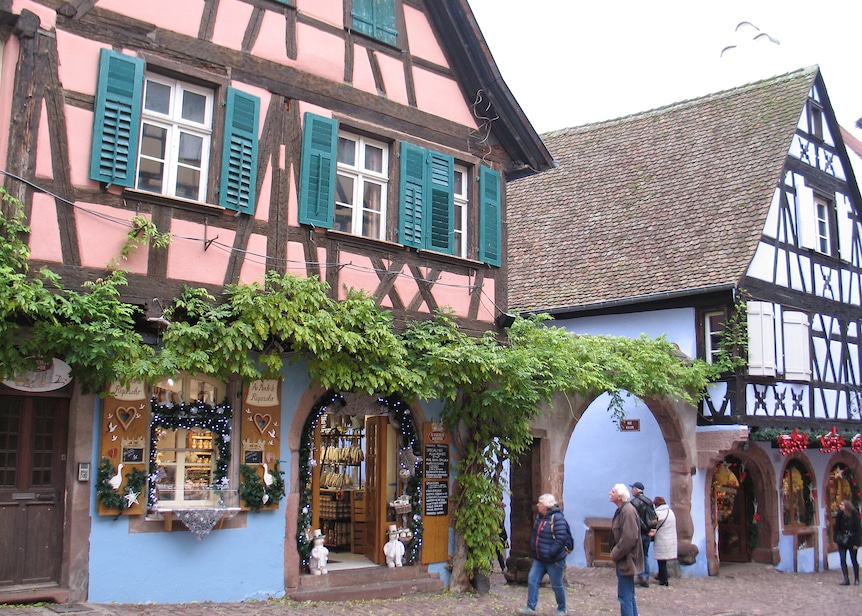
A fairy-tale town amid Alsatian vineyards, tiny Riquewihr has well-stocked shops that sell a variety of Christmas merchandise. Photo by Susan McKee.
The states of Saxony and Bavaria have canceled their Christmas markets. Elsewhere in Germany, hundreds of markets including those in Berlin, Dortmund, Lübeck, Hamburg and Trier remain open. French markets also are open, but many have mask requirements. All markets in Austria are closed.
This year, the Basel Christmas market allows access for visitors aged 16 and over only with a valid Swiss or EU Covid certificate and identity document. Persons under 16 years of age must be able to identify themselves. Those vaccinated or successfully recovered from Covid 19 abroad can apply for a Swiss Covid certificate for a processing fee of CHF 30 (about USD $32). ![]()
Susan McKee travels the world from her base in Indianapolis, Indiana.

